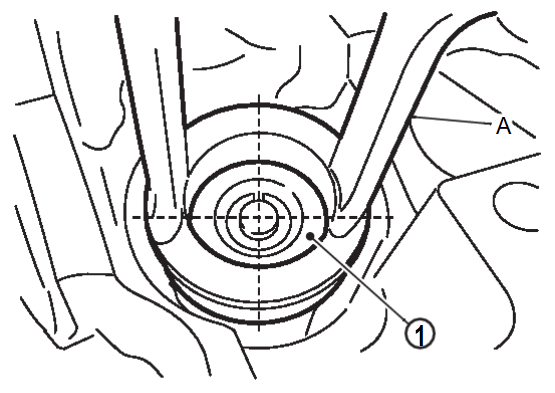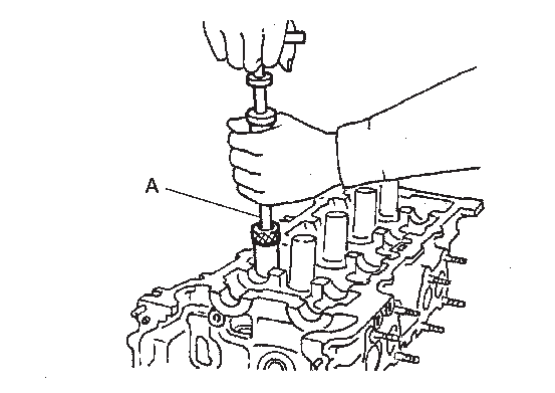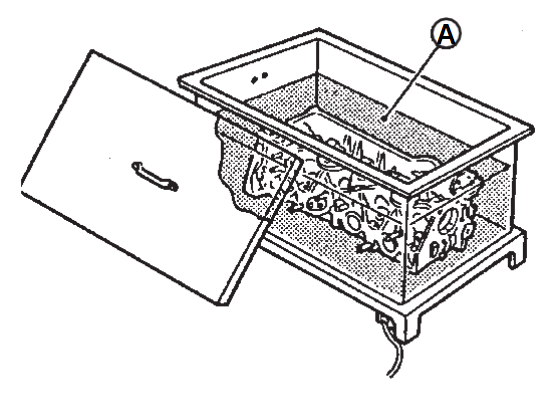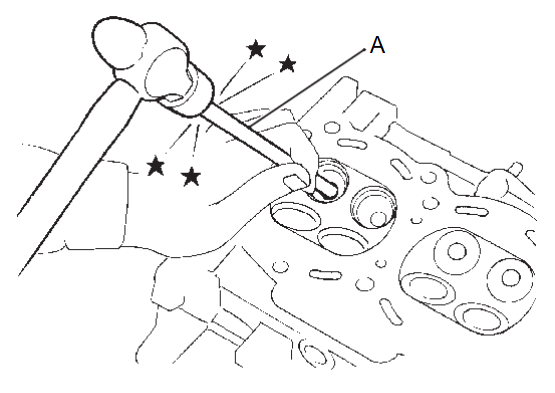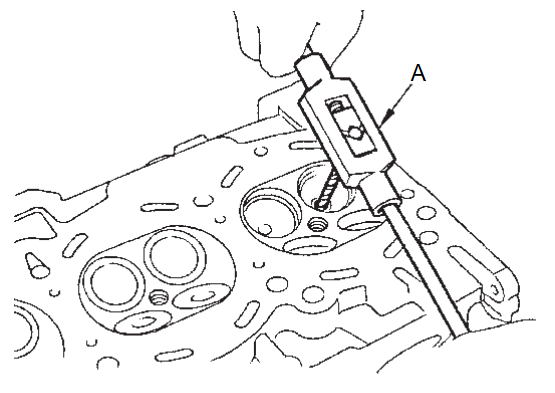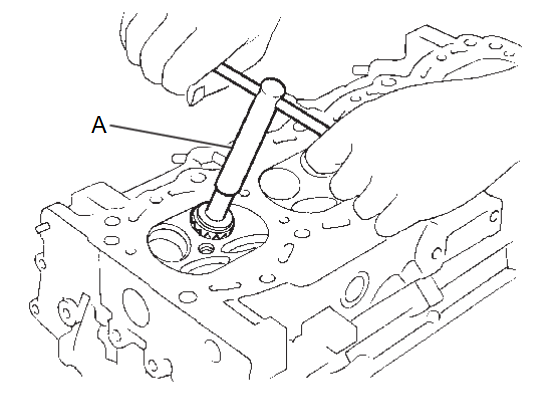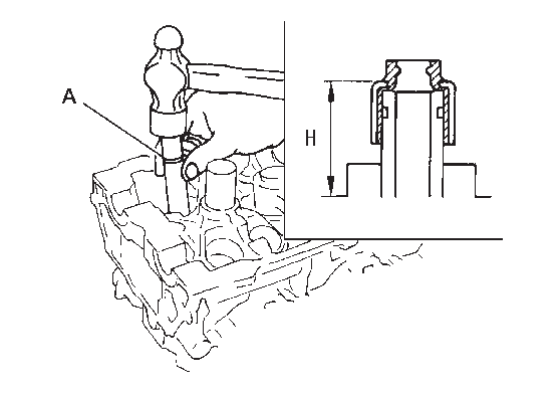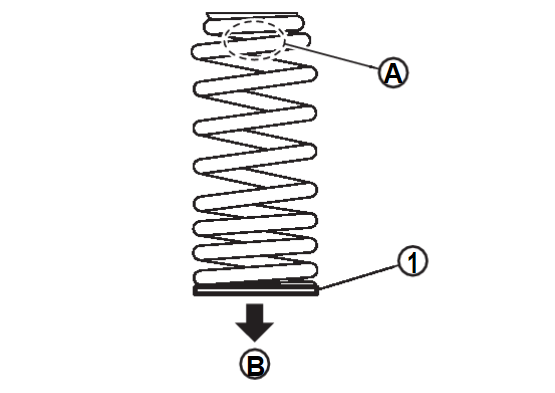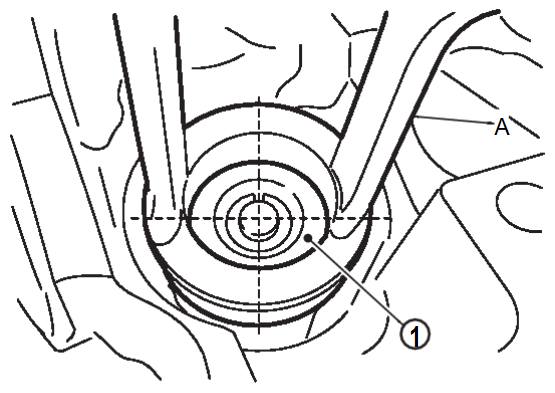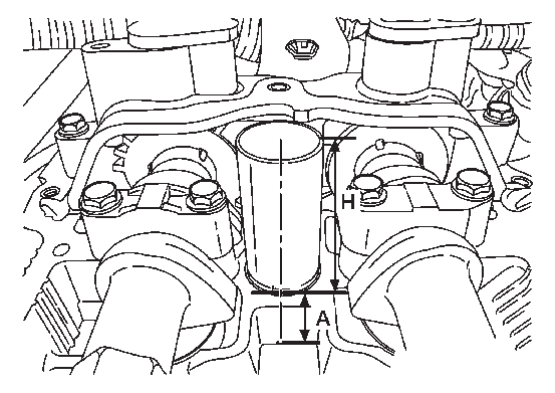Disassembly and Assembly
DISASSEMBLY
1. Remove spark plug with spark plug wrench (commercial service tool).
2. Remove valve lifter.
- Identify installation positions, and store them without mixing them up.
3. Remove valve collet.
- Compress valve spring with valve spring compressor [SST: KV10116200] (A), adapter [SST: KV10109220] (B) and attachment [SST: KV10115900] (C).
| caution |
4. Remove valve spring retainer and valve spring (with valve spring seat).
| caution | Never remove valve spring seat from valve spring. |
5. Push valve stem to combustion chamber side, and remove valve.
- Inspect valve guide clearance. Refer to Inspection

- Identify installation positions, and store them without mixing them up.
7. Remove valve seat, if valve seat must be replaced.
- Bore out old seat until it collapses. Boring should not continue beyond the bottom face of the seat recess in cylinder head. Set the machine depth stop to ensure this. Refer to Cylinder HeadCylinder Head
 .
.caution Prevent to scratch cylinder head by excessive boring.
8. Remove valve guide, if valve guide must be replaced.
(1) To remove valve guide, heat cylinder head to 110 to 130°C (230 to 266°F) by soaking in heated oil  .
.
 .
.9. Remove spark plug tubes (if necessary) using suitable tool.
| caution |
|
ASSEMBLY
1. Install valve guide if removed.
| caution | Replace with oversize [0.2 mm (0.008 in)] valve guide. |
(1) Ream cylinder head valve guide hole with a valve guide reamer (commercial service tool) (A).
| For service parts | : Oversize [0.2 mm (0.008 in)] |
Refer to Cylinder HeadCylinder Head . . | |
(2) Heat cylinder head to 110 to 130°C (230 to 266°F) by soaking in heated oil  .
.
 .
.| warning | Cylinder head contains heat. When working, wear protective equipment to avoid getting burned. |
(3) Press valve guide  from camshaft side to dimensions as shown in the figure.
from camshaft side to dimensions as shown in the figure.
 from camshaft side to dimensions as shown in the figure.
from camshaft side to dimensions as shown in the figure. | :Cylinder head |
| Projection “H” | : Refer to Cylinder HeadCylinder Head . . | |
| caution | Cylinder head contains heat, when working, wear protective equipment to avoid getting burned. |
(4) Apply reamer finish to valve guide with a valve guide reamer (commercial service tool) (A).
| Standard | : Refer to Cylinder HeadCylinder Head . . | |
2. Install valve seat if removed.
(1) Ream cylinder head  recess diameter for service valve seat.
recess diameter for service valve seat.
 recess diameter for service valve seat.
recess diameter for service valve seat. | : Valve seat |
| For service parts | : Oversize [0.5 mm (0.020 in)] |
Refer to Cylinder HeadCylinder Head . . | |
- Be sure to ream in circles concentric to the valve guide center.This will enable valve seat to fit correctly.
(2) Heat cylinder head to 110 to 130°C (230 to 266°F) by soaking in heated oil  .
.
 .
.| warning | Cylinder head contains heat. When working, wear protective equipment to avoid getting burned. |
(3) Provide valve seats cooled well with dry ice. Press-fit valve seat into cylinder head.
| caution |
|
(4) Using valve seat cutter set (commercial service tool) (A) or valve seat grinder, finish valve seat to the specified dimensions. For dimensions, refer to Cylinder HeadCylinder Head .
.
 .
.| caution | When using valve seat cutter, firmly grip the cutter handle with both hands. Then, press on the contacting surface all around the circumference to cut in a single drive. Improper pressure on with the cutter or cutting many different times may result in stage valve seat. |
(5) Using compound, grind to adjust valve fitting.
(6) Check again for normal contact. Refer to Inspection .
.
 .
.3. Apply new engine oil to new valve oil seal joint surface and seal lip.
4. Install valve oil seal.
- Install with a valve oil seal drift [SST: KV10115600] (A) to match dimension in the figure.
note Dimension “H” is height that measured before installing valve spring (with valve spring seat). Height “H” : Inspection 
5. Install valve.
- Install larger diameter to intake side.
6. Install valve spring (with valve spring seat).
- Install smaller pitch (valve spring seat side) to cylinder head side
 .
.
: Valve spring seat - Confirm identification color
 of valve spring.
of valve spring.Intake : Purple Exhaust : Purple
7. Install valve spring retainer.
8. Install valve collet.
- Compress valve spring with valve spring compressor [SST: KV10116200] (A), adapter [SST: KV10109220] (B) and attachment [SST: KV10115900] (C).
caution When working, be careful not to damage valve lifter holes. - Tap valve stem edge lightly with a plastic hammer after installation to check its installed condition.
- The center of the suitable tool (A) and valve spring retainer
 must be aligned.
must be aligned.
9. Install valve lifter.
- Install it in the original position.
10. Install spark plug tube if removed.
- Press-fit it into cylinder head with the following procedure:
(1) Remove old thread locking sealant from cylinder head side installation hole.
(2) Apply thread locking sealant all round on spark plug tube within approximately 12 mm (0.47 in) (A) width from edge of spark plug tube on the press-fit side.
Use Genuine Thread Locking Sealant or equivalent.
(3) Using a drift, press-fit spark plug tube so that height is as same as “H” shown in figure.
| Standard press-fit height “H”: | |
| 41.2 - 42.2 mm (1.622 - 1.661 in) | |
| caution |
|
11. Install spark plug with spark plug wrench (commercial service tool).
![[Previous]](../../../buttons/fprev.png)
![[Next]](../../../buttons/fnext.png)

